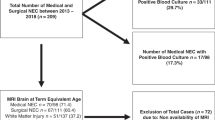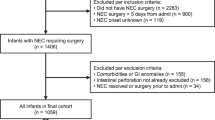Abstract
Objective:
In the past 5½ years, 30 term or near-term neonates in the Intermountain Healthcare system developed necrotizing enterocolitis (NEC) Bell's stage ⩾II. We sought to identify possible explanations for why these patients developed NEC, by comparing them with 5847 others that did not develop NEC, from the same hospitals and of the same gestational ages, cared for during the same 5½-year period.
Study design:
Data were collected from neonates admitted to any of the Intermountain Healthcare NICUs with a birth date from 1 January 2001 to 30 June 2006, and a gestational age >36 weeks. A variety of patient features and feeding practices were compared between those that did vs did not develop NEC.
Result:
Forty-one neonates >36 weeks gestation were listed in the discharge records as having NEC of Bell's stage II or higher. However, on review of these 41 medical records, 11 were seen to have had NEC of Bell's stage I, whereas the remaining 30 had radiographs and clinical courses indicative of Bell's stage ⩾II. Those 30 formed the basis of this study. Twenty-eight of the 30 developed NEC after having been admitted to an NICU for some other reason; the other two developed NEC at home, within 2 days of being discharged from an NICU. The 30 that developed NEC were more likely than the 5847 that did not develop NEC, to have congenital heart disease (P=0.000), polycythemia (P=0.002), early-onset bacterial sepsis (P=0.004) or hypotension (P=0.017). All 30 received enteral feedings before NEC developed; 29 were fed either artificial formula or a mixture of formula and breast milk. The one that was exclusively fed human milk was fed human milk with added fortifier (24 cal/oz). The 30 that developed NEC were more likely to be fed formula exclusively (P=0.000). Seven of the 30 had a laparotomy for NEC; two of the seven had total bowel necrosis and support was withdrawn. The other five had perforations and bowel resections. The mortality rate was 13% (4/30).
Conclusion:
In our series, NEC among term or near-term neonates was exclusively a complication developing among patients already admitted to a NICU for some other reason. We speculate that the combination of reduced mesenteric perfusion and feeding with artificial formula were factors predisposing them to develop NEC.
This is a preview of subscription content, access via your institution
Access options
Subscribe to this journal
Receive 12 print issues and online access
$259.00 per year
only $21.58 per issue
Buy this article
- Purchase on Springer Link
- Instant access to full article PDF
Prices may be subject to local taxes which are calculated during checkout

Similar content being viewed by others
References
Neu J . Neonatal necrotizing enterocolitis: an update. Acta Paediatr Suppl 2005; 94: 100–105.
Rodin AE, Nichols NM, Hsu FL . Necrotizing enterocolitis occurring in full-term neonates at birth. Arch Pathol 1973; 96: 335–338.
Polin RA, Pollack PF, Barlow B, Wigger HJ, Slovis TL, Santulli TV et al. Necrotizing enterocolitis in term infants. J Pediatr 1976; 89: 460–462.
deGamarra E, Helardot P, Moriette G, Murat I, Relier JP . Necrotizing enterocolitis in full-term newborns. Biol Neonate 1983; 44: 185–192.
Goldberg RN, Thomas DW, Sinatra FR . Necrotizing enterocolitis in the asphyxiated full-term infant. Am J Perinatol 1983; 1: 40–42.
Thilo EH, Lazarte RA, Hernandez JA . Necrotizing enterocolitis in the first 24h of life. Pediatrics 1984; 73: 476–480.
Andrews DA, Sawin RS, Ledbetter DJ, Schaller RT, Hatch ET . Necrotizing enterocolitis in term neonates. Am J Surg 1990; 159: 507–509.
Martinez-Tallo E, Claure N, Bancalari E . Necrotizing enterocolitis in full-term or near-term infants: risk factors. Biol Neonate 1997; 71: 292–298.
Fatica C, Gordon S, Mossad E, McHugh M, Mee R . A cluster of necrotizing enterocolitis in term infants undergoing open-heart surgery. Am J Infect Control 2000; 28: 130–132.
Bolisetty S, Lui KJ, Oei J, Wojtulewicz J . A regional study of underlying congenital diseases in term neonates with necrotizing enterocolitis. Acta Paediatr 2000; 89: 1226–1230.
McElhinney DB, Hedrick HL, Bush DM, Pereira GR, Stafford PW, Gaynor W et al. Necrotizing enterocolitis in neonates with congenital heart disease: risk factors and outcomes. Pediatrics 2000; 106: 1080–1087.
Ruangtrakool R, Laohapensang M, Sathornkich C, Talalak P . Necrotizing enterocolitis: a comparison between full-term and pre-term neonates. J Med Assoc Thai 2001; 84: 323–331.
Ng S . Necrotizing enterocolitis in the full-term neonate. J Paediatr Child Health 2001; 37: 1–4.
Ostlie DJ, Spilde TL, St Peter SD, Sexton N, Miller KA, Sharp RJ et al. Necrotizing enterocolitis in full-term infants. J Pediatr Surg 2003; 38: 1039–1042.
Maayan-Metzger A, Itzchak A, Mazkereth R, Kuint J . Necrotizing enterocolitis in full-term infants: case–control study and review of the literature. J Perinatol 2004; 24: 494–499.
Siahanidou T, Mandyla H, Anagnostakis D, Papandreou E . Twenty-six full-term (FT) neonates with necrotizing enterocolitis (NEC). J Pediatr Surg 2004; 39: 791 (comment).
Bell MJ, Shackelford P, Feigin RD, Ternberg JL, Brotherton T . Epidemiologic and bacteriologic evaluation of neonatal necrotizing enterocolitis. J Pediatr Surg 1997; 14: 1–4.
Walsh MC, Kliegman RM . Necrotizing enterocolitis: treatment based on staging criteria. Pediatr Clin North Am 1986; 33: 179–202.
Vermont Oxford Network Database. Manual of Operations. Release 10.0 2005; 77–78.
Feng J, El-Assal ON, Besner GE . Heparin-binding epidermal growth factor-like growth factor reduces intestinal apoptosis in neonatal rats with necrotizing enterocolitis. J Pediatr Surg 2006; 41: 742–747.
Feng J, El-Assal ON, Besner GE . Heparin-binding epidermal growth factor-like growth factor decreases the incidence of necrotizing enterocolitis in neonatal rats. J Pediatr Surg 2006; 41: 144–149.
Feng J, El-Assal ON, Besner GE . Heparin-binding EGF-like growth factor (HB-EGF) and necrotizing enterocolitis. Semin Pediatr Surg 2005; 14: 167–174.
Clark JA, Doelle SM, Halpern MD, Saunders TA, Holubec H, Dvorak K et al. Intestinal barrier failure during experimental necrotizing enterocolitis: protective effect of EGF treatment. Am J Physiol Gastrointest Liver Physiol 2006; 291: G938–G949.
Christensen RD, Havraneck T, Gerstmann DR, Calhoun DA . Enteral administration of a simulated amniotic fluid to very low birth weight neonates. J Perinatol 2005; 25: 380–385.
Barney CK, Lambert DK, Alder SC, Scoffield SH, Schmutz N, Christensen RD . Treating feeding intolerance with an enteral solution patterned after human amniotic fluid: A randomized, controlled, masked, trial. J Perinatol 2007; 27: 28–31.
Bin-Nun A, Bromiker R, Wilschanski M, Kaplan M, Rudensky B, Caplan M et al. Oral probiotics prevent necrotizing enterocolitis in very low birth weight neonates. J Pediatr 2005; 147: 192–196.
Lin HC, Su BH, Chen AC, Lin TW, Tsai CH, Yeh TF et al. Oral probiotics reduce the incidence and severity of necrotizing enterocolitis in very low birth weight infants. Pediatrics 2005; 115: 1–4.
El-Assal O, Marquez A, Besner G . HB-EGF preserves mesenteric microcirculatory blood flow and protects against intestinal injury in rats subjected to hemorrhagic shock and resuscitation. 2007 (submitted for publication).
Lucas A, Cole TJ . Breast milk and neonatal necrotising enterocolitis. Lancet 1990; 336: 1519–1523.
Schanler RJ . The use of human milk for premature infants. Pediatr Clin North Am 2001; 48: 207–219.
Wiedmeier SE, Henry E, Baer VL, Stoddard RA, Lambert DK, Christensen RD . Necrotizing enterocolitis in three level III NICUs within one healthcare system. 2007 (submitted for publication).
Author information
Authors and Affiliations
Corresponding author
Rights and permissions
About this article
Cite this article
Lambert, D., Christensen, R., Henry, E. et al. Necrotizing enterocolitis in term neonates: data from a multihospital health-care system. J Perinatol 27, 437–443 (2007). https://doi.org/10.1038/sj.jp.7211738
Received:
Revised:
Accepted:
Published:
Issue Date:
DOI: https://doi.org/10.1038/sj.jp.7211738
Keywords
This article is cited by
-
Comparison of cardiogenic NEC and classical NEC in the fourth level neonatal intensive care center
Annals of Pediatric Surgery (2023)
-
Morbidity and mortality in neonates with Down Syndrome based on gestational age
Journal of Perinatology (2023)
-
Development of necrotizing enterocolitis in full-term infants with duct dependent congenital heart disease
BMC Pediatrics (2022)
-
Spontaneous intestinal perforation (SIP) will soon become the most common form of surgical bowel disease in the extremely low birth weight (ELBW) infant
Journal of Perinatology (2022)
-
Challenge in diagnosis of late onset necrotizing enterocolitis in a term infant: a case report
BMC Pediatrics (2021)



